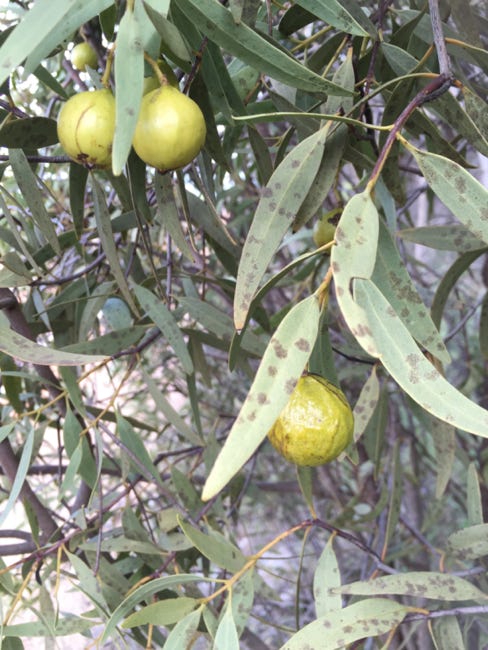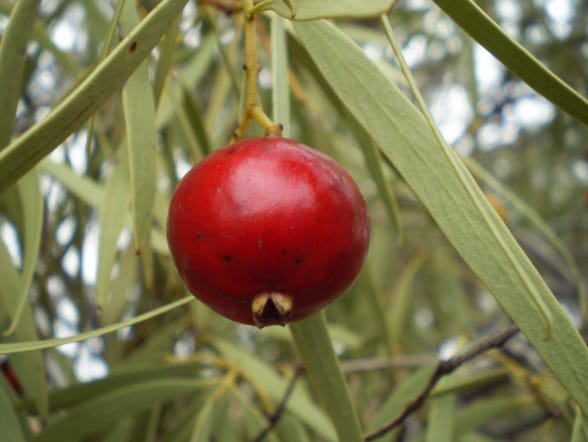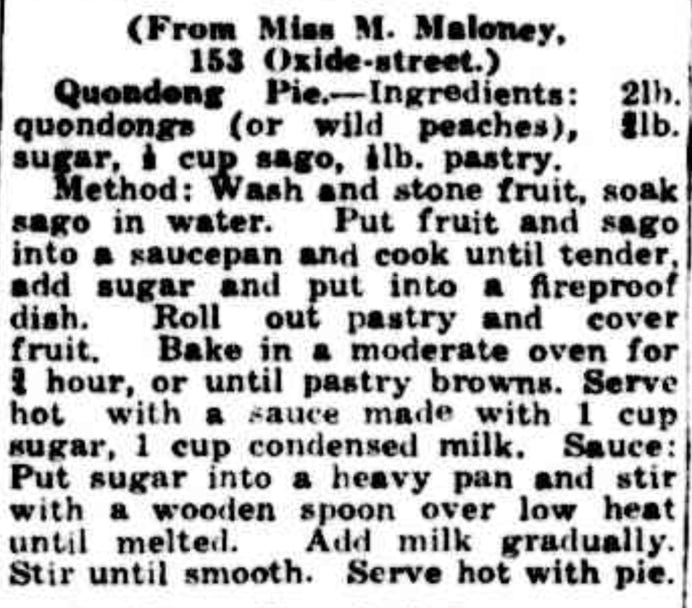Werona - The magic of trees





John Moss via Wikimedia Commons
Where Native Companions dance,
The Willy Wagtail reigns;
Kangaroose hop happily,
Emu graze grassy plains !
Red quondongs hanging on high.
Must have fed dark men, too —
Though quondong-pie with thick cream
A treat they never knew !
~Relics Of The Past in The Henty Observer & Culcairn Shire Register (NSW) Fri 14 Jul 1950 P.2
Barrier Miner (Broken Hill, NSW) Sat 5 Oct 1935 Page 5
Jenreflect via Wikimedia Commons
CSIRO via Wikimedia Commons
SeanMack via Wikimedia Commons
The Werona property was in Mulga country, however there was so much more than Mulga there. If I pause for just a moment I am flooded with memories of: the Poplar Box trees (Eucalyptus populnea) and several other Eucalyptus, Boronias, False Sandalwood (Eremophila mitchellii), Needle Wattle (Acacia rigens), Gidgee (Acacia cambagei), Ruby saltbush (Enchylaena tomentosa), Hop Bush, Emubush (Eremophila), yellow burr daisy (Calotis lappulacea), and Mulla Mulla (Ptilotus). It was very arid country but it could be staggeringly beautiful.
As we made cubby houses in and under many different trees I have memories linked to many species. We gave our own special names to the trees we visited regularly. The names were often based on the tree’s shape. They could also be linked to events playing out in a ‘chapter’ of one of the saga length games that we would play for weeks. The trees functioned as the various sets on our very large stage. Their names were rarely changed, but occasionally an event obscured their attributes. I do not recall the name that we had given the particular tree, but none of us ever forgot the afternoon that we were too frightened to descend from the branches because we thought we had glimpsed the colour of our neighbour’s bull in nearby scrub. The reddish colour that we had spotted from our high vantage point was later revealed to be a sheet of old roofing iron out on our tip. However even when we knew this, that particular tree lost its attraction for us.
One very insignificant woody sapling just outside our back gate gained a place in my permanent memory after Dad transformed it into ‘The Fairy Tree’. We had been to town just days before that magical morning that we tumbled out of the the gate to be greeted by the amazing sight of a tree that was covered in brightly coloured sugar coated soft jubes! Dad had snapped the ends of dozens of small low twigs and skewered jubes onto them.
Our yearly trips in the old yellow Dodge to visit the Quandong trees were almost as ‘magical’ and a lot more healthy. In the southern boundary area of Werona, where it adjoined Murra Murra, there was a small group of Quandong trees. Dad loved Quandongs! He had fond memories of going on ‘Quandong picnics’ with his Grandmother and aunts. The women were good cooks and they used to make the fruit picked on these outings into Quandong Jam, Chutney and Pies. The taste of the raw fruits certainly didn’t make them a treat for me, but I loved visiting that hidden patch of special trees when they were all resplendent with their shiny red fruits. I thought that they were just like something from Enid Blyton’s The Enchanted Wood.
When the fruit of the Quandong is ripe the stone inside becomes loose, and it rattles when the fruit is shaken. During the '40s and '50s Quandong seeds were used as a substitute markers in games such as Chinese checkers. Dad had one of these sets put away carefully in his wardrobe. We never played a game on it, but it was an object of awe and fascination to us.
Desert Quandong (Goorti)
“There are three types of native fruit referred to as quandong. ...Santalum acumination, is generally referred to as quandong, but has many other common names including desert quandong, sweet quandong, native peach, wild peach, desert peach, guwandhuna, gutchu, goorti, katunga and mangata. It grows in arid and semi-arid regions of most states of Australia.” http://www.agrifutures.com.au/farm-diversity/quandong/
“Quandong trees are tolerant of drought and salinity. Foliage is drooping in habit, light grey-green and somewhat leathery in appearance. Small greenish sometimes insignificant flowers in clusters occur from October to March. The tree is more noted for its brightly coloured red fruits ( 2-3 cm.)” http://anfab.org.au/main.asp?_=Quandong
“Quandongs are harvested between late August and early December each year. The thin layer of flesh is peeled from its position over the large kernel which is also edible. Just like the aboriginals did, you can be dry quandongs for later consumption if you have too many to eat now.” https://ekko.world/quandong/160909
“Traditionally, the quandong is an important food source for Australian Aborigines, as it is a good meat substitute when kangaroo or goanna are in short supply. The Aboriginals use the tree and fruit in a variety of ways; the leaves can be used in the production of a topical ointment that may ease skin sores and boils. The roots of the tree are ground down and used as an infusion for the treatment of rheumatism, while the fruit itself can either be eaten fresh, dried or as an infusion for a type of tea. Quandong seeds can also be crushed to make a lotion that can be used to treat skin disorders or even act as a hair conditioner.” https://www.h2g2.com/entry/A9581349 The Quandong tree’s aromatic wood was used by aboriginal people in smoking ceremonies.
“Quandong was a welcome food source for early white settlers and the name quandong was one of 400 aboriginal words adopted into English from the Wiradjuri languages of south-western New South Wales in 1836. The quandong has outstanding anti-oxidant capacity, high levels of folate and vitamin E, and is a good source of magnesium, zinc and iron.” Rural Industries R&D Corporation Factsheet: Focus on Quandong RIRDC Pub. No.14-120 The vitamin C content of Quandongs is higher than oranges and the kernel is very high in fats.
Frazer
- FRAZER - From Kingussie, Scotland, to Sydney, Australia.
- FRAZER - First to Cabramatta and then to Binda, New South Wales.
- FRAZER/MARKS/LAMB - Meeting the neighbours
- FRAZER/MARKS/LAMB - An Inn, Horse Races, and Gold;
- FRAZER - Bullock Drays and Bushrangers.
- FRAZER/MARKS - ‘Markdale’ - On the move again.
- FRAZER/MARKS - They made a long trek north.
- FRAZER - The Queensland story - By 1878 the Fraser family settled in Charleville.
- FRAZER/STEWART/DOODY - Charleville 1892 - Alexander Frazer married Agnes Jane Stewart.
- FRAZER - Wyandra 1905 - Alexander Jnr’s son, Alexander, works as a blacksmith.
- FRAZER - Wyandra 1915 - 1921 - The Great War and A Soldier’s Memorial.
- FRAZER - Will they still remember us?
- FRAZER/GRANT - Wyandra 1921 - 26 - A Marriage, and Christmas Mistletoe.
- FRAZER - Wyandra 1928 - A Fancy Dress Ball.
- FRAZER - Wyandra 1920s - Bullock Wagons to Tractors and Trucks.
- FRAZER - ‘Werona' via Bollon 1930s.
- FRAZER - Barcaldine 1930’s - ‘Avonslea’
- FRAZER - Barcaldine 1936 -1940s - ‘Avonslea’, Elm St. and a Flower Show.
- FRAZER - Brisbane 1950s - 1960s - West End and Coorparoo.
- FRAZER - Southport and Surfers Paradise.
- FRAZER - ‘Werona’ and ‘Beneree’ 1955 to 1970 - ‘Of drought and flooding rain’
- FRAZER - ‘Werona’ - Click go the shears
- FRAZER - Cunnamulla - “I can see the water tower!”
- FRAZER - Cunnamulla 1965 & 1966 - School Days
- FRAZER - ‘Werona’ - The bush hath friends to meet him
- FRAZER - ‘Werona’ - The magic of trees
- FRAZER - ‘Werona’ - A portrait of our chook yard
- FRAZER - ‘Werona’ - The moon is lonely in the sky
- FRAZER - Toowoomba - ‘Someplace Green’
- FRAZER Summary - Alexander Fraser & Margaret McBean to Alexander ('Sonny') Frazer.
- FRAZER 2016 ’Werona’ revisited
- FRAZER - Marks - Lamb - Stewart - Doody -The case is never closed.

